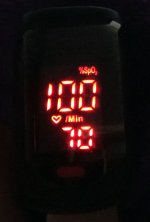Fluorescent lights may be more efficient (more lumens per Watt) than incandescent.
But at 60 Hz an incandescent filament may have enough thermal mass to not strobe. Fluorescent lights can strobe, and for that reason can be a poor choice for illuminating a machine shop. If the strobe frequency matches a machine's operating frequency, often a motor-driven machine, what may be rotating at 3,600 RPM might appear under fluorescent light to be motionless, appear to be turned off. It's not. And bad things have happened to good people as a result.
Some A/C L.E.D. lights are designed, engineered to not strobe. Good idea. It's easier on the eyes for extended reading and other tasks such as sewing.
But more inexpensively engineered alternating current light emitting diodes can flicker, even if too fast for the unaided human eye to detect.
The lights mentioned above can "strobe" flicker on, off, & back on again without a human observer noticing, due to human "persistence of vision". Persistence of vision is why a human can watch an old analog film movie at 24 frames per second, but instead of perceiving 24 consecutive progressive still images, perceives fluid motion.
The light flickers because the alternating current flickers.
Direct current or D/C electricity doesn't do that. A D/C powered L.E.D. shouldn't flicker because the D/C power that drives it doesn't flicker. Right?
I used to think so.
BUT !!
Check out the two following illustrations.
The first image is the display screen of a finger-tip "Pulse Oximeter". Your doctor might already have jammed one of these on your finger in the doctor's office. It displays %SpO2, an indication of how you're processing Oxygen.
The two or three digit number below displays heart beats per minute.
There's also a little bar graph that spikes for each heart beat, also graphically indicating the strength of that particular beat.

This first image shows what the human observer perceives, static display stability, varying only as the sampled parameters vary.
BUT !!
This second graphic shows what a UHD movie camera shows of the Pulse Oximeter in operation.
The Pulse Oximeter operates on internal battery power, D/C.

So if the Pulse Oximeter display operates on D/C power why would it flicker?
Or more to the point, how could it flicker?
Apparently the UHD camera plays a role in this. I've seen similar result on car lights in traffic. To my human eye I see no flicker. But review the sight from a UHD camera and some such lights clearly flicker substantially.
How can an electric light powered by D/C power source do this?
That it happens I have no doubt.
How it happens I have no clue.
You?
But at 60 Hz an incandescent filament may have enough thermal mass to not strobe. Fluorescent lights can strobe, and for that reason can be a poor choice for illuminating a machine shop. If the strobe frequency matches a machine's operating frequency, often a motor-driven machine, what may be rotating at 3,600 RPM might appear under fluorescent light to be motionless, appear to be turned off. It's not. And bad things have happened to good people as a result.
Some A/C L.E.D. lights are designed, engineered to not strobe. Good idea. It's easier on the eyes for extended reading and other tasks such as sewing.
But more inexpensively engineered alternating current light emitting diodes can flicker, even if too fast for the unaided human eye to detect.
The lights mentioned above can "strobe" flicker on, off, & back on again without a human observer noticing, due to human "persistence of vision". Persistence of vision is why a human can watch an old analog film movie at 24 frames per second, but instead of perceiving 24 consecutive progressive still images, perceives fluid motion.
The light flickers because the alternating current flickers.
Direct current or D/C electricity doesn't do that. A D/C powered L.E.D. shouldn't flicker because the D/C power that drives it doesn't flicker. Right?
I used to think so.
BUT !!
Check out the two following illustrations.
The first image is the display screen of a finger-tip "Pulse Oximeter". Your doctor might already have jammed one of these on your finger in the doctor's office. It displays %SpO2, an indication of how you're processing Oxygen.
The two or three digit number below displays heart beats per minute.
There's also a little bar graph that spikes for each heart beat, also graphically indicating the strength of that particular beat.

This first image shows what the human observer perceives, static display stability, varying only as the sampled parameters vary.
BUT !!
This second graphic shows what a UHD movie camera shows of the Pulse Oximeter in operation.
The Pulse Oximeter operates on internal battery power, D/C.

So if the Pulse Oximeter display operates on D/C power why would it flicker?
Or more to the point, how could it flicker?
Apparently the UHD camera plays a role in this. I've seen similar result on car lights in traffic. To my human eye I see no flicker. But review the sight from a UHD camera and some such lights clearly flicker substantially.
How can an electric light powered by D/C power source do this?
That it happens I have no doubt.
How it happens I have no clue.
You?
